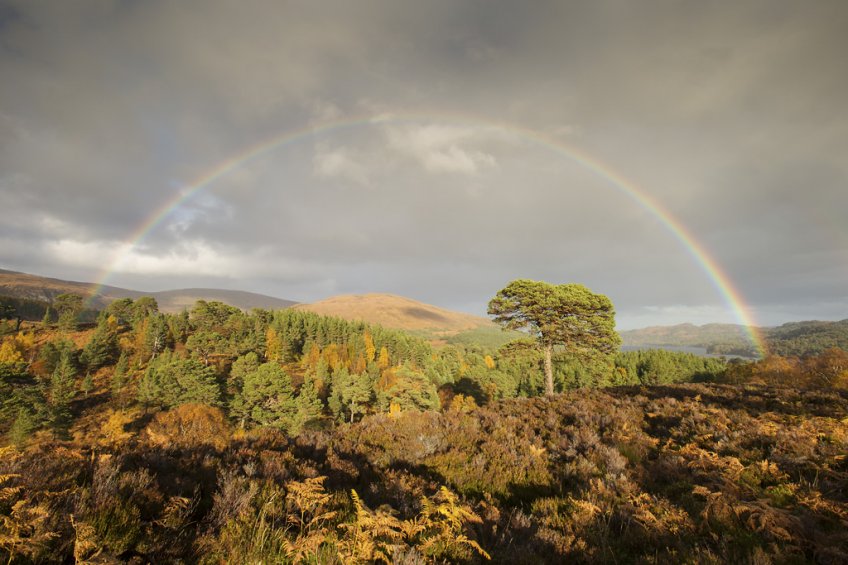Nature-depleted Scotland needs new era of rewilding says landmark book
A sticking plaster approach to conservation is failing Scotland’s wildlife – and with species such as red squirrel, wild cat and capercaillie declining or on the edge of extinction, a new era of massive rewilding is needed, says a landmark new book from Trees for Life and SCOTLAND: The Big Picture.
Scotland has the space and opportunity to take a fresh approach, with people working with nature, not against it, and allowing ecosystems to restore themselves on a large-scale, say the authors of Scotland: A Rewilding Journey, which is being launched in Inverness this evening.
 “Right now, nature is in steep decline – but Scotland is perfectly placed to become a rewilding world-leader. Our wild places can flourish if we allow nature to work in its own way on a big scale, with a helping hand in places. There would be huge benefits for people – from our health and wellbeing to creating sustainable jobs in rural areas,” said Steve Micklewright, Chief Executive of Trees for Life.
“Right now, nature is in steep decline – but Scotland is perfectly placed to become a rewilding world-leader. Our wild places can flourish if we allow nature to work in its own way on a big scale, with a helping hand in places. There would be huge benefits for people – from our health and wellbeing to creating sustainable jobs in rural areas,” said Steve Micklewright, Chief Executive of Trees for Life.
Illustrated by world-class images captured by top nature photographers over three years, and with essays from leading commentators, the book lays out an inspiring vision of how rewilding forests, peatlands, rivers, moorlands and the ocean could transform Scotland for the better.
Deforestation, deer and sheep grazing, burning moors for grouse hunting, exotic conifers and denuded seas have left Scotland as one of the world’s most nature-depleted countries, its landscapes supporting fewer people than previously as a result. Climate change now poses a major threat.
Returns or rebounds of species like beavers, sea eagles and pine martens happen slowly. Birds of prey like hen harriers are persecuted. Wolf, crane, wild boar, elk and lynx were all made extinct long ago.
“For decades we've been trying to save nature piecemeal – a rare bird or insect here, a fragment of woodland there. But climate change and biodiversity loss now present critical threats to our survival, and saving bits and pieces of nature isn’t enough. As a wealthy country with plenty of space, we can do so much better,” said the book’s co-author Peter Cairns, Director of SCOTLAND: The Big Picture.
 Despite superb nature reserves, amazing patches of Caledonian pinewood and new Marine Protected Areas, nature is now hugely fragmented and diminished across Scotland. Its awe-inspiring landscapes are often ecological deserts, stripped of woodlands. Only 1.5 per cent of its land is national nature reserves, while a quarter is ecologically impoverished grouse moors or deer forests.
Despite superb nature reserves, amazing patches of Caledonian pinewood and new Marine Protected Areas, nature is now hugely fragmented and diminished across Scotland. Its awe-inspiring landscapes are often ecological deserts, stripped of woodlands. Only 1.5 per cent of its land is national nature reserves, while a quarter is ecologically impoverished grouse moors or deer forests.
Scotland’s seas are in trouble too – with wild salmon stocks declining, heavy dredging raking the sea floor, and gannets feeding their chicks plastic waste.
The book’s publication aims to be a watershed moment in the rapidly growing movement for rewilding, and a catalyst for change by shifting attitudes and perceptions, and sparking debate and discussion.
Momentum for rewilding has been highlighted by widespread calls for the return of the lynx, reintroduction of beavers, and initiatives such as Cairngorms Connect – a land manager partnership that is enhancing habitats across a vast stretch of Cairngorms National Park.
There has also been huge public support for Scotland: A Rewilding Journey’s publication. The book was funded by a successful crowdfunding appeal run by Trees for Life, and is supported by an alliance of organisations including Reforesting Scotland, Rewilding Britain, Rewilding Europe, The Borders Forest Trust, The European Nature Trust, and Woodland Trust Scotland.
Bringing back trees would be a good start for major rewilding. Only four per cent of Scotland is native woodland. Rewilded woodlands like Glen Affric could be enjoyed across the country by expanding pinewoods into a grand nationwide network. This would help red squirrels, crested tits and capercaillie, which can’t cross large areas of open ground and are now imprisoned in isolated islands of woodland.
The book aims to encourage conversations and cooperation between different audiences and groups. Rewilding can co-exist well with farming, forestry and recreational activities.
It encourages conservationists and landowners to work together with mutual respect. Cooperation between deer managers and conservationists could help resolve over-grazing in the Highlands – which prevents woodlands from regenerating – with sporting traditions enjoyed in more natural settings.
Soaring deer numbers could also be managed by allowing the return of apex predators such as wolf and lynx, when the time is right and when public opinion is prepared to welcome them back.
Restoring large areas of wild places could provide employment, especially in the Highlands and Islands. Otters, deer, puffins and sea eagles all support a growing nature tourism economy.
Nature’s benefits also include beavers preventing flooding, trees providing food, and peatlands soaking up carbon dioxide. Studies show how nature boosts people’s health, and is good for children.
Scotland: A Rewilding Journey (£25 from www.scotlandbigpicture.com)is published by SCOTLAND: The Big Picture, a non-profit social enterprise that includes leading nature photographers and filmmakers, and promotes the benefits of a wilder Scotland through stunning visual media.
All images on page © scotlandbigpicture.com

